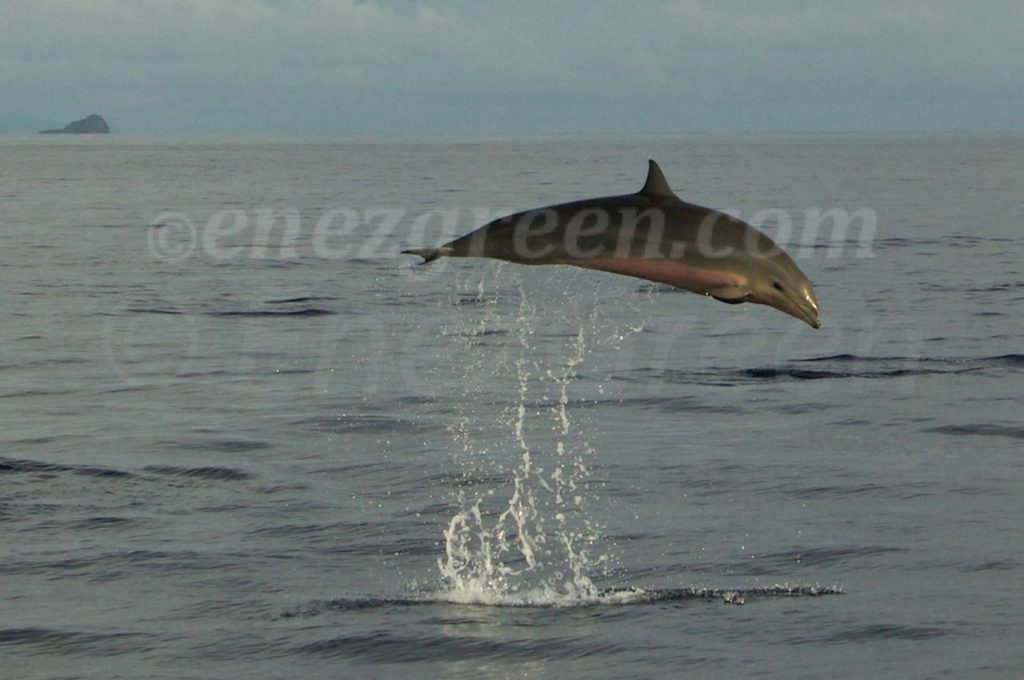A favourable setting for the sperm whales settlement
A very vast oceanic trench of about 2,000 m deep is situated a few miles away from the coast of Dominica. The seabed rapidly gets deeper and this configuration seems to perfectly suit sperm whales which reside there all year round. Dominica is one of the rare places in the world, and the only place in the Caribbean where such behaviour can be observed.
Sperm whales are mammals that can dive to tremendous depths. It can stay under the water for an hour without breathing and can dive to depths of 2,000 m to 3,000 m. They usually dive to such depths to look for food, navigating by echolocation. The essentially feed on squids but are not put off by fish and octopuses.
Male sperm whales measure up to 20 m long and weigh up to 45 tons. Females are smaller, measuring some 12 m long and weighing up to 18 tons. The sperm whale has a gigantic head which can measure 3 m high and 6 m long. They have the largest brains of any living animal.
An island with remarkable marine biodiversity
While sperm whales reside all year round in the western part of the island, various other cetacean species can be seen around Dominica. Between November and June, you may come across humpback whales (Megaptera novaeangliae) which come there for reproduction purposes. Many other species such as the minke whale (Balaenoptera acutorostrata) and the Bryde’s whale (Balaenoptera edeni) also reside there.
A number of dolphins can be seen in the waters of Dominica, namely spinner dolphins, Pantropical spotted dolphins, bottlenose dolphins and common dolphins. Pantropical spotted dolphins are quite common in the Caribbean. Shoals of hundreds of specimens, which are playful, expressive and mischievous in nature, can regularly be seen.
Killer whales, which usually travel in groups of up to 10 individuals, can be less frequently seen. Short-finned pilot whales (Globicephala macrorynchus) can also be encountered in the waters of Dominica.
Remarkable experience and service with Anchorage
Anchorage started its cetacean watching activity in 1988, at a time when very few centres cared about their presence. Needless to say, that the Armour brothers were true pioneers in sperm whale watching. It seems humans have been able to develop a special relationship with these giants of the sea through frequent encounters with some specimens. Judging by photos of people swimming with these sea animals, they appear to have built an almost friendly relationship.
A whale watching session with Anchorage begins with some detailed explanation on the way of life and social behaviour of cetaceans, which are the fruit of thousands of observations that have been carefully recorded in writing after each outing for the information of the greatest number of people via American scientific bodies.
The outing is undertaken aboard a comfortable catamaran that is equipped with a large upper deck to provide excellent conditions to observe the sea.
The presence of a hydrophone on board, which offers multiple advantages, is much appreciated. The first advantage is that it enables fast location of the cetaceans. This saves you from having to randomly navigate the stretch of water and limits the nuisance for the animals, most of which are sperm whales and dolphins that have settled permanently in the waters of Dominica. This reduces fuel consumption, and thus pollution, very significantly. The hydrophone also enables an accurate identification of the species spotted and the approximate distance from its location point. The hydrophone on board the Anchorage boat is connected to loud speakers, which enables the passengers to listen to the strange sounds from the depths.
You will be pleased to note that the encounters with sperm whales, dolphins and whales offered by Anchorage take place in excellent conditions and with the utmost respect for the cetaceans. All the observations made on board are put down in writing and forwarded to scientific bodies. The guides are all highly motivated, and their passion is contagious.




